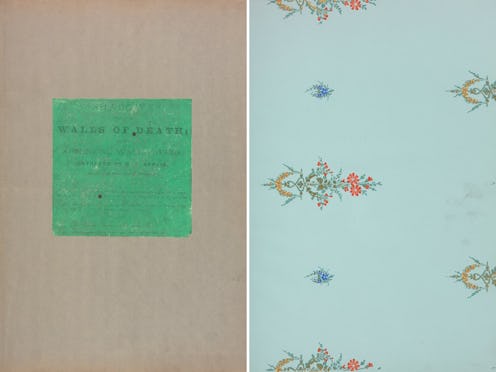Atlas Obscura is a one-stop shop for your next conversation-starting fact, but a Tuesday article might disturb book dragons everywhere. Shadows from the Walls of Death is a collection of wallpaper samples published in 1874, but it's also the one book you don't want to collect, no matter how much you love 19th-century literature. Put simply, this is a book that can kill you.
Victorians in Great Britain and the U.S. papered their walls with brightly colored patterns, from geometrics to floral arrangements. Unfortunately, many of those colors, the greens in particular, were made by combining arsenic with copper. Although it was widely known that ingesting arsenic would kill someone, most Victorians believed that the chemical could be used safely in paint and cosmetics.
Convinced that arsenic was killing many people slowly in their homes, the author of Shadows from the Walls of Death, Robert M. Kedzie, set out to prove the dangers of using the chemical in one's everyday life. The author's life was almost as interesting as the story of his book, Kedzie having been a surgeon in the Union Army, a professor at Michigan State Agricultural College (MSU), and a member of the Michigan State Board of Health. His argument "that arsenical wallpapers shed microscopic dust particles that can be inhaled or ingested," though correct, was disruptive in its time, but it didn't get rid of arsenical wallpaper immediately. According to The Ann Arbor Chronicle, "[i]n 1887, the American Medical Association estimated that between 1879 and 1883, 54–65% of all wallpaper sold in the United States contained arsenic, a third of which at dangerous levels."
Consisting of 86 pages, most of which are arsenical wallpaper samples, Shadows from the Walls of Death went to 100 Michigan libraries with warnings not to allow children to touch it. Only four of those copies remain, because, as Atlas Obscura notes, "[m]ost libraries, concerned about poisoning their patrons, destroyed their volumes." Two of the surviving texts are held at the University of Michigan and at Kedzie's alma mater of MSU, where visitors and librarians alike must wear protective gloves in order to handle them. The book has been digitized for safe, public consumption.
Perhaps more interesting than its deadliness is the effect Shadows from the Walls of Death has on the reading of a famous, feminist short story. Published in 1892, Charlotte Perkins Gilman's "The Yellow Wallpaper" tells the story of its unnamed narrator, a woman whose husband — a doctor — takes her to a rented house in the country to recover from what we would call postpartum depression today. Confined to bed-rest in an upstairs room, the narrator is slowly driven mad by her chambers' ugly, yellow wallpaper, which seems to move around her. Knowing that the Victorians' wallpaper contained deadly arsenic, which can cause hallucinations, the narrator's insanity in "The Yellow Wallpaper" feels much more real, rather than a supernatural or psychological manifestation.
To read more interesting reporting from Atlas Obscura, pick up the book! Atlas Obscura: An Explorer's Guide to the World's Hidden Wonders is available now at your favorite bookstore.
